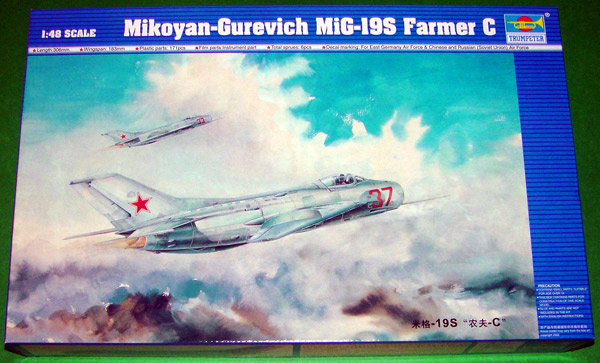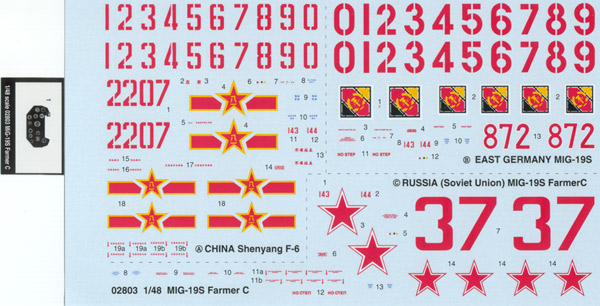|
MiG-19S Farmer C
MiG-19PM Farmer E
and FT-6 Trainer

Trumpeter
S
u m m a r y
|
| Catalogue Number
and Description: |
2803 (MiG-19S), 2813 (FT-6), and
2804 (MiG-19PM) |
| Scale: |
1/48 |
| Price: |
USD$49.95 each
(USD$42.96 from Squadron.com) |
| Contents and Media |
171 – 239 plastic parts, 1 acetate
sheet (instruments) |
| Review Type: |
FirstLook |
| Advantages: |
Nice surface and cockpit detail,
good job of including the differences between the various versions, hollow
gun muzzles. |
| Disadvantages: |
Fuselage air intake doors missing, a
few sinkmarks, bombs supplied only in the version that doesn’t carry them,
more decals should have been provided for the East German aerobatic bird. |
| Recommendation: |
Recommended |

Trumpeter's
1/48 scale family of MiG-19s are available online from Squadron
Reviewed by Dave
Williams
Following the release of their MiG-19 kits in
1/32 scale, Trumpeter has now released the Farmer in the smaller scale for the
shelf space challenged crowd.
Essentially, the kits are scaled down versions
of the large kits and many of the comments in the previous review of the 1/32
scale kits also apply to the 1/48 scale kits. The main difference between the
two scales is that the 1/48 scale kits delete the complete engines and mold each
fuselage half in one piece instead of splitting them front and back.
Other minor differences are the deletion of
the nose avionics boxes, although the hatch is still a separate piece and the
nose splitter has a well where the boxes would be, different breakdown of the
KK-2 ejection seat parts, and the smaller kit only includes non-flattened
wheels. Otherwise, the parts are almost identical to the larger kits.
Like their 1/32 scale cousins, the three kits consist of a mixture of sprues
common to all three versions and sprues specific to the version being kitted.
The common sprues contain the wings, the landing gear, the cannons and the drop
tanks. Specific sprues contain the fuselage, cockpit, and clear parts. The PM
kit also contains an extra sprue with the missile armament and has a different
tail sprue. Although the pictures in this review are only of the Farmer-C kit,
the other two kits are essentially the same in quality.
Overall, the molding quality is about the same as in the larger kits. The main
exterior parts such as the wings and fuselage are free of sinkmarks and exterior
defects, although the separate speed brakes have some surface ripples on the
exterior and ejector pin marks on the inner detail. Also, there is a sink mark
on the front of the F/FT-6 parabrake housing. Again, the portion of the tail
below the rudder is a separate part to allow for the parabrake housing on the
Chinese-built versions. The control surfaces are separate parts, although the
flaps are not designed for repositioning. Like the big kits, most of the air
scoops on the fuselage are molded separately; however many are one solid piece
and need to be drilled out to represent the actual intake. The instructions make
no mention of the need to add any nose weight, which seems strange considering
the distance of the large tail from the main gear struts. Given that the HiPM
kit requires weight in the nose; one should consider taping together the major
parts to check the balance about the main gear attachments before closing up the
forward fuselage halves.
Click the
thumbnails below to view larger images:
As noted previously, each fuselage half in one
piece, with each kit having a unique fuselage mold. Unfortunately, the new
fuselage omits some notable details that were present in the larger kits. The
most obvious item is that Trumpeter has failed to represent the four auxiliary
intake doors on the fuselage that are located above the wing roots and were
frequently seen open while the aircraft was on the ground. These doors, as well
as the panel they are on, were molded as separate parts in the 1/32 kits. Like
the large kit, the Mig-19S fuselage has the late gun blast panel configuration
which had two square pads replacing the large oval panel. The 1/32 scale kit had
these pads correctly represented as raised surfaces, but the 1/48 scale kit
merely provides recessed outlines of the pads. You are own your own in painting
the darker area of the fuselage that was originally covered by the large oval
panel as there is nothing to provide a guide for masking the panel.
The wings are molded without the cannons in the root. If a cannon-armed version
is built, a portion of the wing root must be removed to install the cannon.
Cannon barrels both with and without the muzzle brakes are included. The cannon
barrels are one piece; however their muzzles are already hollowed out. In
addition, a separate panel is provided for the upper wing root which contains
either the three vents seen on cannon-armed aircraft, or is plain for non-cannon
birds. Identical to the 1/32 scale kits, the wings lack the conventional
tab-and-slot attachment point. Instead, they are a butt joint to the fuselage
with the rear wing root fairing molded on the forward fuselage halves providing
positioning. There are also some sinkmarks on the alt part of the lower wing
root.
The level of cockpit detailing is similar to the larger kit and makes for an
acceptable cockpit out of the box if no one chooses to make an aftermarket set.
The KK-2 seat consists of 5 parts (down from 11 parts in the 1/32 scale kit) and
just needs the addition of some belts (not included) for completeness. The
instrument panel consists of a clear panel that is placed over an acetate sheet
with printed instrument dials.
The clear parts are relatively thin and free of distortion. Antenna lines are
molded inside the tops of the single-seater canopies. Trumpeter’s use of a
multipart mold results in a center seam on the canopy which must be removed. The
single-seater canopy slides along a track in the cockpit panel aft of the seat
and appears to be movable after building.
The wheel wells are separate pieces which ensures the surface detail on the
upper wings is not marred by sinkmarks. The gear struts look good, although
there are some ejector pin marks on one side that should be filled. Only
non-flattened tires are included.
All kits include the wing tanks and associated pylons, and the pylon fitted
under the inboard leading edge of the wing. The inboard pylons were popular on
Chinese-built aircraft and East German Farmers, but were not fitted to Soviet
and other Warsaw Pact aircraft. The strange backward pylons fitted aft of the
main gear wells and used for carrying ORO-57K rocket pods on the MiG-19S are not
included.
2803 MiG-19S
Like all of the kits, includes the option of
braked or unbraked cannon, and optional parabrake housing for the J-6/F-6.
Although the instructions tell you to use the unbraked cannon and parachute
housing on the Chinese aircraft, note that early F-6 aircraft lacked the chute
housing and had the muzzle brakes on the cannon, so check your references for
the particular aircraft you are doing.
Markings are the same as the 1/32 scale kit,
namely: Soviet “Red 37” and Chinese J-6 “Red 2207”, both in NMF, and “Red 872”,
a colorful East German Farmer C specially painted for the Fifth Word Aerobatic
Championship in 1968 (the real aircraft crashed before the competition ).

Unfortunately, like the larger kit, only the
nose number and national insignia are included for “Red 872”. You are left to
your own devices to paint the colorful scheme, which includes a large red
lightning bolt down the side with a thin white outline. The bolt should probably
have been provided as a decal as it will be very difficult to paint the outline.
Some stenciling is included on the decal sheet, but the instruction sheet makes
no mention of where they go.
2813 FT-6
Markings are included for Pakistani FT-6
“Black 10106” and Chinese JJ-6 “Red 41483”, both in NMF. This is a slight change
from the 1/32 scale kit, in which the Pakistani markings were for a camouflaged
bird.
2804 MiG-19PM
The kit contains an extra armament sprue which
contains four RU-2U and four RU-2US missiles and associated missile rails. The
kit also contains various OFAB bombs and the instructions mention how to
assemble them, but they are not shown in the loadout table included in the
instructions, and it seems doubtful that –PMs would be used for ground attack
duties. Save the bombs for other kits. Markings are included for Soviet MiG-19PM
“Blue 30”, East German MiG-19PM “Red 723”, and Chinese F-6B “Red 14121”. All
aircraft are in NMF.
It has been a long road to getting a decent
1/48 Farmer kit.
In recent years, we have been treated first to
the AA kit, which was more of a toy than a true representation of a MiG-19.
Besides lacking detail, the fuselage was noticeably too short. Then came the
HiPM kit, which isn’t a bad kit and is relatively accurate, but suffers from
some of the downsides of “limited run” kits such as thick parts and lack of
detail on parts such the landing gear.
While not fully Tamigawa quality, the
Trumpeter kits are easily the best of the lot and should build up nice out of
the box, although at $50 USD, they might seem a little pricey for some wallets.
Recommended.
Sample kits courtesy of my ever dwindling
bank account.
Dave Williams
IPMS/USA 19050
Review Copyright © 2001 by Dave
Williams
Page Created 08 December, 2002
Last updated 22 July, 2003
Back to HyperScale
Main Page
Back to Reviews
Page
|
Home | What's
New | Features
| Gallery |
Reviews | Reference
| Forum
| Search